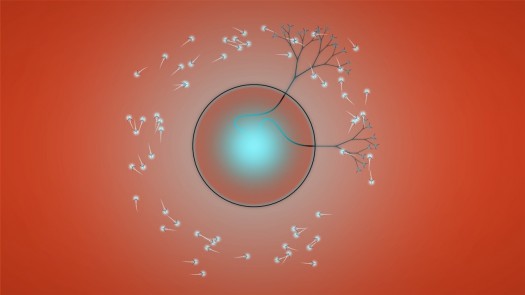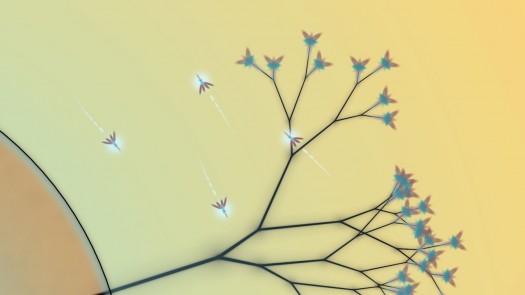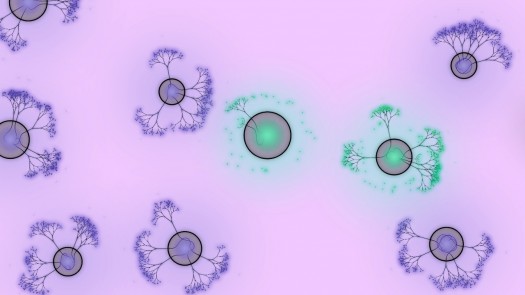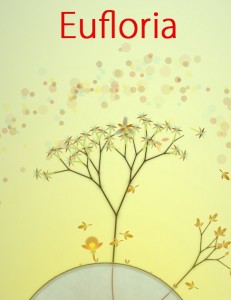 It’s 2012, and I’ve had a few years to conjure a snappy explanation of what Eufloria is and how it rolls. I haven’t. So, before I even get into how much I dig it on iPad, I’ll let my main man Rudolf Kremers — one of the handful of dudes behind the original release — do the talking. In our latest “bonus" podcast, he cheekily broke it down like this:
It’s 2012, and I’ve had a few years to conjure a snappy explanation of what Eufloria is and how it rolls. I haven’t. So, before I even get into how much I dig it on iPad, I’ll let my main man Rudolf Kremers — one of the handful of dudes behind the original release — do the talking. In our latest “bonus" podcast, he cheekily broke it down like this:
“Eufloria is a game of space, conquest, and exploration based on themes of plant life and flowers rather than space marines and spaceships."
That’s the thing about Eufloria: it’s an RTS that goes against the grain. It doesn’t have any big dudes in big armor smashing space orcs in the face with apartment-sized space maces. It also doesn’t subscribe to any particular feel or taste, or really, any action-y RTS conventions. It’s a minimalist strategy game that has some cool, laid-back creative touches, and it’s all wrapped up in a sensitive production overhead that conveys the game’s core design ideals and gentle pacing well.
This much has been proven in past iterations. And for the most part, what you’ve seen is what you’ll be getting Day Zero on iPad. Eufloria on iPad still looks gorgeous, it still runs as smooth as ever, and all the little technical touches on the movement, placement and execution phases of the game have made it over. But, on the other hand, I’m not seeing a major adjustment on anything anyone has complained about before — the balance appears to be still a little touch and go, and in some of the levels I’ve been playing, the pacing is slow (unless you manually crank up the overall game’s speed).
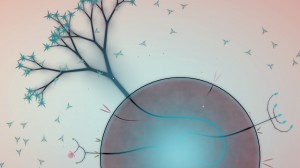 What the iPad port does bring, though, are new ways to interact more intimately with the experience. Pinch and zoom can be used liberally to explore every little nook and cranny of each level. Satisfying drag, hold, and swipe gestures take care of the rest. It’s all good stuff.
What the iPad port does bring, though, are new ways to interact more intimately with the experience. Pinch and zoom can be used liberally to explore every little nook and cranny of each level. Satisfying drag, hold, and swipe gestures take care of the rest. It’s all good stuff.
I asked Kremers after the show to explain what he was shooting for with this version’s controls. He said that the main idea was to strip “all barriers between playing the game and the device you play it on." Mission accomplished as far as I’m concerned. This is appears to be as much of a lean-back experience as ever before, and delightfully so.
Here’s a breakdown for those of you just seeing Eufloria for the first time. This is a game about asteroids, trees, and tiny, winged seedlings. In almost every scenario, the goal is to take these seedlings to an asteroid, build a tree or two, and then usher even more seedlings on to other asteroids. The tech tree is simple: trees build seedlings and asteroids have one of three different effects on seedlings, either making them strong or fast or energetic. As trees age, they become more potent and harder to kill. Eventually you’ll see some variations on unit types as well as a defensive tree that’ll keep enemy seedlings off of your rock.
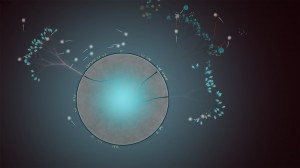 The strategy factors into the picture in a variety of ways. You can’t hit up an asteroid unless you have an asteroid connected to it. Also, most asteroids are inhabited, so you’ll need to kill the enemy seedlings and then destroy their trees, which are jacked into that asteroid’s core. Cracking the core boils and tearing down an impromptu space settlement boils down to a numbers game: basically, whoever has the larger wad of dudes wins. Much later in the game, you’ll be given very specific tasks, like say, defending or finding a path through a system.
The strategy factors into the picture in a variety of ways. You can’t hit up an asteroid unless you have an asteroid connected to it. Also, most asteroids are inhabited, so you’ll need to kill the enemy seedlings and then destroy their trees, which are jacked into that asteroid’s core. Cracking the core boils and tearing down an impromptu space settlement boils down to a numbers game: basically, whoever has the larger wad of dudes wins. Much later in the game, you’ll be given very specific tasks, like say, defending or finding a path through a system.
On our show, Kremers explained where these ideas came from. Eufloria proper is based on a proof-of-concept called “Dyson," which is named after a british physicist who theorized that you could explore space by growing mechanical trees on asteroids. It’s neat to see this crazy idea living on in a game.
The beauty of Eufloria is in its simplicity; it’s artfully stripped of graphical clutter and is fairly bare-boned on the UI and sound front. It’s also strikingly easy to play for a strategy game since most of the action happens on a macro-level: clicks, drags, and drops compose all you’ll need for galactic takeovers. This type of game feels great on iPad, and it seems like Team Eufloria and Tunatech pulled it off.
My time with the preview build, for reasons of avoiding anything other than modest scrutiny at this phase in its pre-release form, has been artificially shortened, so I don’t have a verdict for you. You’ll get that later at some point this month when the game sees a release across iOS at an unannounced price. We’re expecting more details to roll in shortly. Fingers crossed.
All the screens in this write-up are from the PSN version of the game. I can’t tell a difference between the two in picture-form.
UPDATE: We didn’t mention the game’s 3X speed setting in the original write-up.
